How to Water Polka Dot Plant (Frequency, Amount, Ways & Solution)
Written by LisaSmith
Jan 31 2023
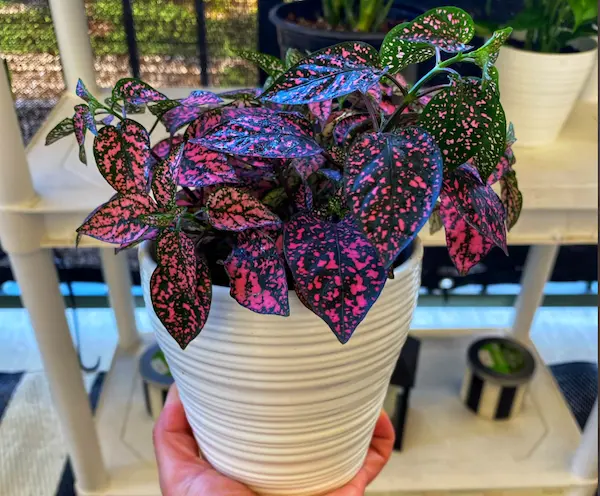
Polka Dot Plants (Hypoestes Phyllostachys) are native to Madagascar and indigenous to Nigeria, which are temperate countries with warm and moist climates. Thus, Polka Dot Plant thrives well in moist well-drained soil but not soggy soil. Like most houseplants, underwatering is better than overwatering because it is a plant prone to root rot. As we all know, root rot is often the most serious problem of plant health. However, if your Polka Dot Plants don’t get adequate water, they will also tend to droop, wilt or even leggy growth. Don’t let the soil dry out completely between waterings.
Mastering the correct watering method is one of the keys to growing attractive Polka Dot Plants with variegated oval leaves. Keep reading on how to water Polka Dot Plant.
When to Water Polka Dot Plant
Besides using your “instinct” to water the plant, there are many signs or ways telling you that it’s time to water Polka Dot Plant or not. For a busy plant lover, these are surely perfect solutions since you possibly have forgotten when you watered your plant last time.Touch Soil
Moist soil tends to be darker in color than dry soil and so simply by looking you can get an idea of whether the soil is wet or not. However, the soil on the surface may dry quickly but lower down it could still be moisture. At this time, stick your finger into the soil about 2 inches (5 cm or the second knuckle) to feel if the soil is still damp. Water when the first half-inch of soil turns a little dry. Instead of a finger, a light-colored stick is also useful if it is wet after being inserted into the soil.Weight of the Pot
Moist soil is surely heavier than dry soil. First, we can water the whole Polka Dot plant thoroughly. Get a general idea of the weight of the plant after it has been watered. If the surface of the basin is found to be dry. Then you weigh the pot. If it's much lighter, there's basically no water left in the basin. Just water the polka dot plant thoroughly. (Read More: How Much Light Does a Polka Dot Plant Need)Wilting or Drooping Leaves
If observing the potting soil is not a good indicator of whether water is needed, you can also look at the condition of the Polka Dot plants. If the plant leaves appear wilting, drooping with no luster, then it is an obvious signal of water shortage. It is better not to wait until this stage, because it may cause damage to the roots of the Polka Dot plant.Leggy Growth
If you’re inconsistent with watering and the soil mix of the Polka Dot Plant often dries out between watering days, it will cause leggy growth. Because lack of watering will also affect their photosynthesis, it prevents the plant from growing a strong stem and leafing out well. Read More: How to Fix a Leggy Polka Dot Plant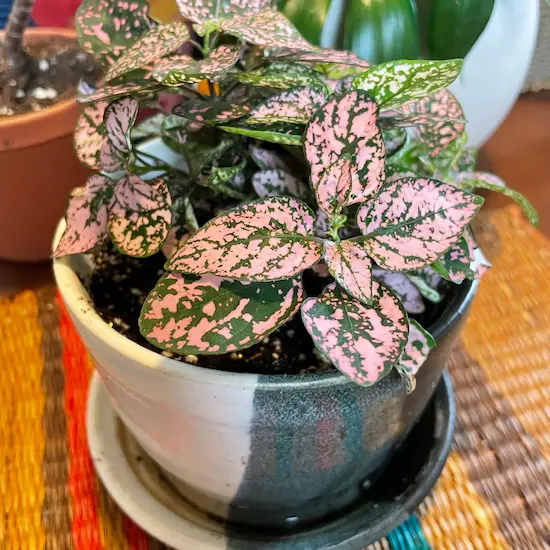
How Often & How Much to Water Polka Dot Plant
The most golden rule of watering polka dot plants is to keep the soil consistently moist but not soggy. That means you will need to water the plant often unless you are growing it in a terrarium. As I mentioned before, observe your plant before you decide to water the Polka Dot Plant. The frequency of watering will greatly depend on the soil mix as well as the environment's humidity. The following tips of how much and how often to water polka dot plant is only suitable for the most common situation.Polka Dot Plant Watering in Spring
Polka Dot plants like a moderate amount of moisture in the soil at all times. In spring, in order to encourage plant growth, a diluted liquid houseplant fertilizer is typically applied once a month. So the watering should be controlled to avoid root rot. Let the top ¼- ½ inch of soil be fairly dry between waterings. Check the soil moisture every 2-3 days.Polka Dot Plant Watering in Summer
In summer, Polka Dot Plants will experience a fast-growing season. Hot weather in summer means you need to water the plants more frequently to ensure the soil is consistently moist. At this time, water will evaporate very quickly. So when the top ¼ inch of soil has dried out, it’s time to water your Polka dot plant again. Usually, you need to check the soil moisture every day.Polka Dot Plant Watering during Flowering
While a Polka Dot Plant infrequently blooms when grown indoors, it produces small purple attractive flowers in summer or early fall. Blooming will cost a lot of nutrition, so the Polka Dot Plant water requirements will be much higher just before flowering and during flowering. It’s generally difficult to stop your Polka Dot Plant flowering, so water more regularly at this time.Polka Dot Plant Watering in Winter
Cut back a little on watering during winter when the Polka Dot plant usually grows slowly or enters a dormant state. Wait until the top ½ inch of soil has dried out between waterings. Check the soil moisture every week. In winter, move your plant indoors then water it. It has a weak tolerance to cold. If watering the polka dot plant in winter outdoors, it may cause frostbite. (Read More: How Long Do Polka Dot Plants Live)Ways to Water Do Polka Dot Plant
Picking an ideal watering method can effectively avoid overwatering or underwatering. Always water with room temperature water.Watering Polka Dot Plant Root
This is one of the most common and easiest ways to water Polka Dot Plants. When watering, except for flushing the roots with water to lift the roots, under normal circumstances, the spout should not be too high from the surface of the basin, so as not to wash away the soil and moss.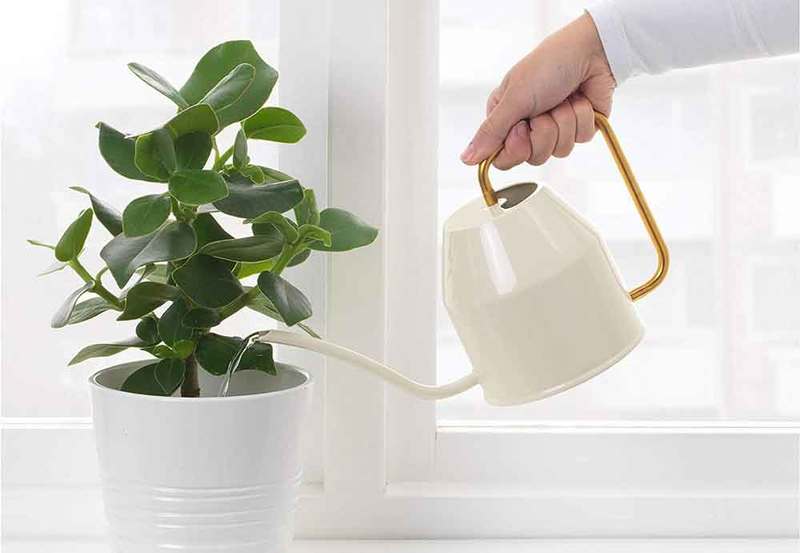
Watering Roots (Plant in Image is not Polka Dot Plant)
Watering Polka Dot Plant Leaves
This method is not suitable for watering Polka Dot plants, which may cause leaves to rot or leggy growth.Newly propagated Polka Dot plants from division or repotted plants can be sprayed with a little water on leaves in order to make up for the lack of water absorption by the root system, which can improve the survival rate and speed up rejuvenation.
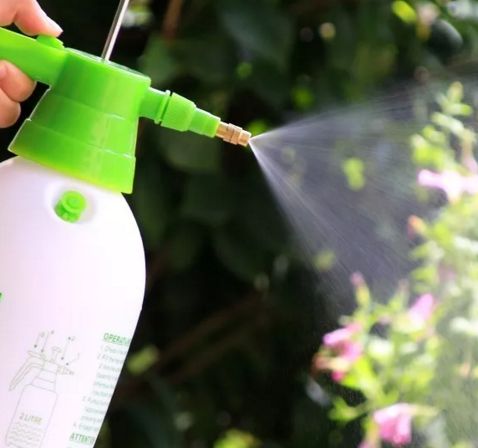
Spray Water on Leaves
Bottom Watering for Potted Plants
Small potted Polka Dot plants can be watered by this method. Put small, miniature pots into a deeper bigger empty basin, add water to the basin, making water seep into basin soil from the drainage hole of the small pot bottom. Wait for the soil of small pots to become wet and they are watered thoroughly.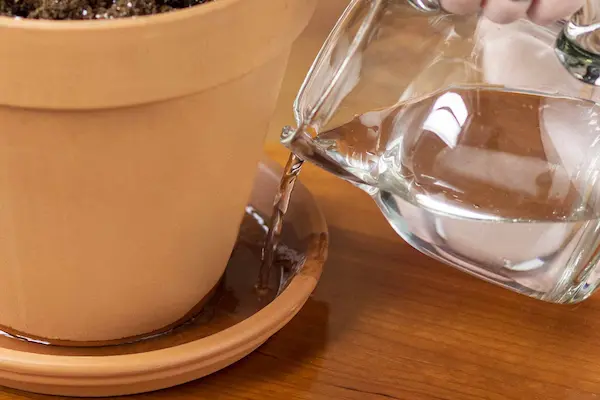
How to Save an Overwatering Polka Dot Plant?
Polka dot plants enjoy moist, airy soil. If it is overwatered, the leaves will often turn yellow and brown. Eventually, the root will rot, the leaves will fall off and the whole plant will die if not being processed in time. If it doesn’t occur root rot, you can just reduce water and adjust your water frequency. If it starts to root rot, depending on the extent of the damage, you can either repot or propagate Polka Dot Plant. If the damage is small, you can just repot your plant. While if the damage to the roots is severe, you may need to propagate a new plant.Read Next:
- How to Propagate Polka Dot Plant
- Polka Dot Plant: Facts, Care & Propagation Guide
- How to Fix a Leggy Polka Dot Plant
- Do Polka Dot Plant Flower Bloom
- Polka Dot Plant Light Requirements
How Do You Know If Your Polka Dot Plant Needs Watering?
When a polka-dot plant needs watering, it will likely exhibit some distress symptoms, as you would expect from most plants. The majority of these indications should be easy to find by closely examining the plant. Alternately, you could run a quick test.
1- Check Moisture Level Using a Stick Or Finger Test
This easy test can be done without spending any money. Just insert your finger or a measuring device into the ground.
- If the top quarter-inch of the soil is still moist, wait out for a day or two then check again
- If the top ¼- ½ inch of the soil has dried out, that's a fair sign your plant needs watering
In addition, watch out for prolonged wetness and muckiness of the soil.
2- Check Potting Soil Color
You can examine the color of the soil in addition to determining how dry it is. I notice that moist soil looks darker than dry soil. The soil has most likely dried out enough to require watering if it appears grayish.
I don't just use this method, like the majority of knowledgeable gardeners do. To validate my preliminary conclusions, I typically run a stick or finger test.
3- Inspect the Plant for Wilting Or Drooping Leaves
I've noticed that polka-dot plants that have been submerged continue to grow lush. But as soon as you notice any indications of wilting or drooping leaves, you should water them.
However, take note that wilting, curling, or drooping foliage is a sign of severe dehydration. So, you shouldn't wait for that to happen.
4- Brown Leaf Tips
A leaf's tips or edges that appear dry, brown, and dead are never a good sign. This is frequently a sign that your plant needs to be watered because it is extremely dehydrated.
It pays to be aware that there are a number of other reasons why the brown leaf tips on polka-dot plants may appear. Other potential causes you need to look into include dehydration, overwatering, edema, sunburn, and salt buildup.
5- Leaves Wrinkling
Typically, leaf wilting, curling, and drooping off occur simultaneously. Like other drought-tolerant plants, polka-dot plants wrinkled their leaves as a natural defense against excessive dehydration.
6- Are Leaves Turning Brown Or Yellow?
Both underwatering and overwatering can cause the foliage of your polka-dot plant to turn yellow or brown. You should immediately give your plant a thorough and appropriate watering. If you don't, the plant will eventually die because the foliage will dry out.
7- Leaves Drying Out and Falling Off
You have a very small chance of reviving your priceless polka if this is taking place. This indicates that it is past due for you to water your plant. Some of the leaves may have started to yellow, wilt, or brown before they dried out and fell over, as you may have seen.
You should move your plant into some shade and give it plenty of water. Keep it there until the leaves regain their vibrant hue and their freckled coloring.
8- Measure the Weight of the Pot
You need to have a general idea of the pot's default weight before using this method. In the presence of sufficient moisture, potted plants typically weigh more. If there is a significant weight loss, water your polka as soon as possible.
9- Use Moisture Meter
If your plant is too particular about its water needs, you should turn to using a moisture meter. The soil moisture level should be easier for you to gauge with greater accuracy. You should spend your money on a multi-use gardening meter to get the most value.
Your plant needs watering if the reading on a scale of 1 to 10 is 3 or less.
Signs of Overwatered Polka-Dot Plant
- The leaves will frequently turn brown or yellow if you've overwatered your polka-dot plant.
- Because roots aren't functioning properly, leaves are limp, droopy, or wilting.
- Water-logged soils – you must be careful when using the can if the ground feels squishy and wet.
- Both fresh and old leaves are being shed by your plant.
- Any indications of root rot, a fungus disease connected to waterlogging.
- Because of excessive watering, your polka-dot plant's base frequently weakens, swells, or emits a foul odor.
- The leaves of your plant could get watery brown spots with yellow haloes. These are obvious indications that you have a bacterial infection.
- You may notice water pressure buildup
How to Water Polka Dot Plant
You want consistent moisture for your polka-plant. You should choose the best watering technique for your circumstances because of this.
1- Watering from Above
-
- Avoid overhead irrigation at all costs. Splashes make your polka leaves more susceptible to bacterial and fungal disease.
- Purchase a watering can with a small nozzle that won't wet the leaves.
- When the top ½ inch of the soil has begun to dry out a little, water it well. You must only water early in the morning or later in the evening. until the bottom is completely drained of water.
- After ten minutes, empty the excess water on the bottom.
2- Watering from Below
You'll quickly learn that the best results come from watering your polka-dot plant from below. You should therefore buy a durable saucer with pebbles.
- Filling the saucer with fresh, distilled, or filtered water should be your first step.
- To avoid sluggishness, scatter some dry pebbles.
- Place the water saucer or tray on top of your pot.
- Wait until the soil is uniformly moist then dump out excess water
3- Self-Watering Pots
Self-watering pots are the perfect solution if you want a watering method that you can set and forget. Overwatering or underwatering won't keep you up at night. The self-watering pot will handle all the hard work for you if you simply fill the reservoir as needed.
Golden Rules of Watering
1- Keep the Soil Evenly Moist
If the soil is not evenly moist, this will result in isolated water-logged areas that will promote root rot.
2- Dry Out Between Watering
Before giving your polka-dot plant another watering, be sure the top quarter to half inch of the soil has dried out. However, this does not imply that the soil must be completely dried out.
3- Water Early Morning Or Water Late Evening
Any spills or splashes on the leaves will have plenty of time to dry off before it gets warmer during the day if you water in the early morning or late evening.
4- Do Not Wet the Leaves
The majority of bacterial and fungal diseases that could affect your polka thrive in warm, humid weather. To prevent these microbes, you must leave the leaves as dry as possible.
5- Ensure Water Reaches the Roots
Water the plant thoroughly until the bottom drain holes are filled with water. This makes sure that the soil doesn't dry out by the time the roots have absorbed enough water.
6- Avoid Waterlogging
Your polka-dot plant's worst adversary is soggy soil. As a result, the roots are unable to breathe properly and cannot effectively absorb nutrients and water.
7- Use Well Drainage Capacity Soil
In well-drained soil, polka-dot plants thrive. This indicates that the potting mix is well-aerated and won't become soggy from watering. This serves two purposes by preventing root rot and ensuring adequate absorption.
Read More: Are Polka Dot Plants Toxic to Cats
Watering Polka Dot Plants After Repotting
After every year or two, you might want to repot your polka-dot plant. In this manner, you can revitalize and reinvigorate your priceless plant using a new, more fertilized potting mixture.
Additionally, if there are serious problems, you might want to repot your polka sooner. These include severe waterlogging, chemical toxicity, excessive fertilization, extreme salt buildup, and others.
Overwatering your newly potted polka-dot plant is the absolute last thing you want to do. After all, the main reason for their demise is overwatering. This is particularly true before the plant in its new pot has grown roots again. It's best to err on the side of caution.
Here are a few steps you need to take to properly water your polka dot plant after repotting:
- Make sure the new pot has holes on the bottom for draining extra water and enhancing aeration. This will ensure that the new pot is well-drained. Before repotting, the potting mixture needs to be pre-moisturized.
- Create a tray or saucer: If you want to water from the bottom, you need to have a good saucer that is filled with pebbles.
- Make sure the new potting mix has an even moisture level by adding water. This will guarantee even root development.
- Check frequently: Nearly every day, check the soil for indications of waterlogging or dryness. Verify that the leaves are not wet. Rewater your replanted plant if the top ¼ to ½ inch of soil has dried out.
Last Words
- Your polka-dot plant is more likely to suffer from overwatering than underwatering
- Water only after the soil has reasonably dried out from the top ¼ to ½.
- Wintertime watering should be less frequent; springtime through summer and fall should be more frequent.
Latest Updated
- How Long Do Polka Dot Plants Live - How to Extend Their Life
- Are Polka Dot Plants Toxic to Cats - What to Pay Attention
- How Much Light Does a Polka Dot Plant Require?
- How to Water Polka Dot Plant (Frequency, Amount, Ways & Solution)
- How to Fix a Leggy Polka Dot Plant (Reasons & Solutions)
- Do Polka Dot Plant Flowers Bloom
- How to Propagate Polka Dot Plant (Ways & Steps)
- Polka Dot Plant (Hypoestes Phyllostachya Baker) Care & Propagation Guide
- Philodendron Golden Goddess vs Lemon Lime - Are They The Same
- Philodendron Lemon Lime vs Moonlight - Differences
Popular Articles
- Winter maintenance of Antirrhinum Majus
- How to Grow Terminalia Mantaly Tree
- How to Grow and Care for Crossostephium Chinense
- How to grow Antirrhinum Majus in spring
- Peristeria Elata (Dove Orchid) Profile: Info & Care Guide
- Underwatered Snake Plant (Sansevieria Trifasciata) - Signs And How To Fix
- How to Care for Brazilian Jasmine Plant (Mandevilla Sanderi)
- Rosa Chinensis (China Rose): Plant Growing & Care Tips
- How to Grow & Care for Graptopetalum Purple Delight in Summer
- How to Care for Baby Sun Rose (Aptenia Cordifolia)